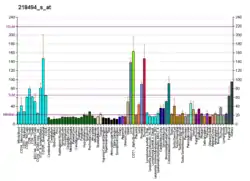SLC2A4RG
SLC2A4 regulator is a protein that in humans is encoded by the SLC2A4RG gene.[3][4]
| SLC2A4RG | |||||||||||||||||||||||||
|---|---|---|---|---|---|---|---|---|---|---|---|---|---|---|---|---|---|---|---|---|---|---|---|---|---|
| Identifiers | |||||||||||||||||||||||||
| Aliases | SLC2A4RG, GEF, HDBP-1, HDBP1, Si-1-2, Si-1-2-19, SLC2A4 regulator | ||||||||||||||||||||||||
| External IDs | OMIM: 609493 HomoloGene: 88865 GeneCards: SLC2A4RG | ||||||||||||||||||||||||
| |||||||||||||||||||||||||
| |||||||||||||||||||||||||
| Orthologs | |||||||||||||||||||||||||
| Species | Human | Mouse | |||||||||||||||||||||||
| Entrez |
| ||||||||||||||||||||||||
| Ensembl |
| ||||||||||||||||||||||||
| UniProt |
| ||||||||||||||||||||||||
| RefSeq (mRNA) |
| ||||||||||||||||||||||||
| RefSeq (protein) |
| ||||||||||||||||||||||||
| Location (UCSC) | Chr 20: 63.74 – 63.74 Mb | n/a | |||||||||||||||||||||||
| PubMed search | [2] | n/a | |||||||||||||||||||||||
| Wikidata | |||||||||||||||||||||||||
| |||||||||||||||||||||||||
The protein encoded by this gene is a nuclear transcription factor involved in the activation of the solute carrier family 2 member 4 gene. The encoded protein interacts with another transcription factor, myocyte enhancer factor 2, to activate transcription of this gene.[4]
References
- GRCh38: Ensembl release 89: ENSG00000125520 - Ensembl, May 2017
- "Human PubMed Reference:". National Center for Biotechnology Information, U.S. National Library of Medicine.
- Oshel KM, Knight JB, Cao KT, Thai MV, Olson AL (Sep 2000). "Identification of a 30-base pair regulatory element and novel DNA binding protein that regulates the human GLUT4 promoter in transgenic mice". J Biol Chem. 275 (31): 23666–73. doi:10.1074/jbc.M001452200. PMID 10825161.
- "Entrez Gene: SLC2A4RG SLC2A4 regulator".
Further reading
- Bonaldo MF, Lennon G, Soares MB (1997). "Normalization and subtraction: two approaches to facilitate gene discovery". Genome Res. 6 (9): 791–806. doi:10.1101/gr.6.9.791. PMID 8889548.
- Xu XR, Huang J, Xu ZG, et al. (2002). "Insight into hepatocellular carcinogenesis at transcriptome level by comparing gene expression profiles of hepatocellular carcinoma with those of corresponding noncancerous liver". Proc. Natl. Acad. Sci. U.S.A. 98 (26): 15089–94. doi:10.1073/pnas.241522398. PMC 64988. PMID 11752456.
- Deloukas P, Matthews LH, Ashurst J, et al. (2002). "The DNA sequence and comparative analysis of human chromosome 20". Nature. 414 (6866): 865–71. doi:10.1038/414865a. PMID 11780052.
- Strausberg RL, Feingold EA, Grouse LH, et al. (2003). "Generation and initial analysis of more than 15,000 full-length human and mouse cDNA sequences". Proc. Natl. Acad. Sci. U.S.A. 99 (26): 16899–903. doi:10.1073/pnas.242603899. PMC 139241. PMID 12477932.
- Tanaka K, Shouguchi-Miyata J, Miyamoto N, Ikeda JE (2004). "Novel nuclear shuttle proteins, HDBP1 and HDBP2, bind to neuronal cell-specific cis-regulatory element in the promoter for the human Huntington's disease gene". J. Biol. Chem. 279 (8): 7275–86. doi:10.1074/jbc.M310726200. PMID 14625278.
- Knight JB, Eyster CA, Griesel BA, Olson AL (2004). "Regulation of the human GLUT4 gene promoter: interaction between a transcriptional activator and myocyte enhancer factor 2A". Proc. Natl. Acad. Sci. U.S.A. 100 (25): 14725–30. doi:10.1073/pnas.2432756100. PMC 299781. PMID 14630949.
- Gerhard DS, Wagner L, Feingold EA, et al. (2004). "The status, quality, and expansion of the NIH full-length cDNA project: the Mammalian Gene Collection (MGC)". Genome Res. 14 (10B): 2121–7. doi:10.1101/gr.2596504. PMC 528928. PMID 15489334.
- McGee SL, Sparling D, Olson AL, Hargreaves M (2006). "Exercise increases MEF2- and GEF DNA-binding activity in human skeletal muscle". FASEB J. 20 (2): 348–9. doi:10.1096/fj.05-4671fje. PMID 16368714. S2CID 13881696.
This article is issued from Wikipedia. The text is licensed under Creative Commons - Attribution - Sharealike. Additional terms may apply for the media files.


